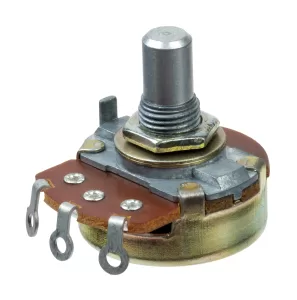
Potentiometer Working Principle: An Insightful Journey
December 04 2023 
Inquiry
Global electronic component supplier AMPHEO PTY LTD: Rich inventory for one-stop shopping. Inquire easily, and receive fast, customized solutions and quotes.
QUICK RFQ
ADD TO RFQ LIST
Potentiometers are incredibly useful parts in the field of electronics because they combine control and signal manipulation in one cohesive unit. Their versatility in controlling both the resistance and output voltage has rendered them essential in a vast range of applications, encompassing feedback circuits and audio equipment. In this blog, we will delve into the intricacies of potentiometers, unraveling their working principle, exploring their diverse types, and uncovering their vast array of applications.
What are Potentiometers?
Potentiometers, which are three-terminal variable resistors with a variable output voltage within a predefined range, are commonly referred to as "pots" in the electronics industry. A wiper contact that can be moved and slides along a resistive element—usually a conductive track or wire—comprises them. A proportionate change in the output voltage is produced by varying the resistance between the wiper and one of the fixed terminals by adjusting the wiper's position.
Types of Potentiometers
Potentiometers come in various configurations to suit different applications and requirements. The most common types include:- Linear potentiometers: These show a linear relationship between the output voltage and the wiper position, i.e., a continuous variation in the output voltage is produced by a constant variation in the wiper position.
- Rotating potentiometers: These are frequently utilized in volume regulators and other settings where a revolving shaft is used to modify the wiper position.
- Slide Potentiometers: Mixer consoles and guitar volume controls are two common uses for slide potentiometers, which have a sliding mechanism to move the wiper.
- Digital potentiometers: Using digital commands, these integrated circuits provide precise control and flexibility by fusing a resistive element and a digital interface.
Can Potentiometers Be Used to Measure Current?
Potentiometers are not used for measuring direct current; instead, their main applications are in voltage division and signal control. Even though they can change the output voltage to indirectly indicate changes in current, they are not as precise and accurate as is needed for accurate current measurement.What are Potentiometers Used For?
- Volume Controls: To change the volume level, potentiometers are widely used in audio equipment like stereos, amplifiers, and guitars.
- Feedback Circuits: By supplying a variable input signal, potentiometers are used in feedback circuits to control a variety of parameters, including gain, speed, and temperature.
- Position Sensing: To convert mechanical movement into an electrical signal, potentiometers are used in position-sensing applications such as joysticks, potentiometers, and robotic manipulators.
- Voltage Dividers: Potentiometers serve as voltage dividers in a variety of circuits, supplying a variable voltage output for uses such as voltage biasing and conditioning sensor signals.
How Potentiometers Work?
According to the wiper position, potentiometers divide the applied voltage across the resistive element. Depending on the connection, the output voltage is either zero or the full supply voltage when the wiper is at one end of the element. A variable voltage output is produced when the wiper advances toward the other end, causing the output voltage to change proportionately.- The Resistive Element
- Imagine an electron "highway" formed by a long, thin wire or other resistive material.
- The potentiometer's total range is determined by the resistance of this element. Less voltage changes for the same wiper movement are associated with higher resistance.
- Terminals: The Entry and Exit Points
- The electron flow enters and exits through two terminals, which function similarly to toll booths on a "highway."
- The electrons are forced through by a "pressure difference" created when voltage is applied across these terminals.
- The Wiper
- This is the main attraction! A rotating or sliding contact that moves along the resistive element in a manner similar to how a car changes lanes on a "highway."
- You can adjust the wiper's position and the area it touches by turning a knob or sliding a slider.
- Resistance: The Pothole Factor
- The resistance between the wiper and its neighboring terminal increases with the length of the "highway" segment the wiper touches. Imagine the electron flow being slowed down by more potholes along a longer road.
- Lower resistance, akin to a smooth stretch that allows electrons to flow through, is present in the untouched section.
- Voltage Division
- By dividing the total voltage across the element according to the resistance of each section, the wiper functions as a voltage divider.
- Because of the higher resistance wiper section, there is a greater voltage drop, similar to the car losing energy from potholes, which reduces the amount of "pressure" for the remainder of the trip.
- A smaller voltage drop occurs in the unaffected area, similar to an automobile traveling more smoothly and encountering less resistance.
- Output Voltage
- The output voltage of the potentiometer is determined by the voltage at the wiper terminal and the resistance it encounters. This is analogous to checking the voltage (pressure) at the checkpoint after the vehicle has driven through the challenging area.
- You can control this output voltage anywhere from 0 (the wiper at one end) to the full input voltage (the wiper at the other end) by adjusting the wiper and resistance. Consider controlling the vehicle's speed by selecting various, varying-hard lane options.
- Modes of Operation
- Rheostat mode: Use the wiper and just one outer terminal when in rheostat mode. Similar to a variable resistor, the wiper regulates the overall resistance and current flow over the whole "highway." Imagine adjusting the difficulty for every car by closing one toll booth and directing all traffic through the other.
- Voltage divider mode: Use the wiper as well as the outer terminals when in voltage divider mode. The wiper is a flexible tool for regulating different circuit characteristics because it splits the input voltage into two adjustable outputs. Consider keeping both toll booths open and controlling the flow of vehicles (voltage) to various locations.
- Real-World Applications
- Potentiometers are tiny voltage cooks that regulate everything from your phone's screen brightness to the radio's volume.
- They translate your hand movements into electrical signals that control the game, serving as silent partners in joysticks.
- Potentiometers are used by robots and drones as well to sense their position and precisely adjust their movements.
Video related to How Potentiometers Work
When Were Potentiometers Invented?
Early in the 19th century, a number of inventors contributed to the development of the potentiometer concept. A device known as the "Poggendorff compensator," invented in 1821 by Johann Christian Poggendorff, used the potentiometer principle to measure voltages precisely. A more useful potentiometer was later created by Edward Davy in 1840, which opened the door for its widespread use in electrical circuits.What Causes a Potentiometer to Fail?
Potentiometers can fail due to various factors, including:- Mechanical Wear and Tear: The wiper contact may deteriorate with time, producing noise and output voltage instability.
- Contamination: The resistive element may get accumulated with dust, dirt, and other contaminants, which would raise the resistance and change the output voltage.
- Heat Damage: An excessive amount of heat can harm the wiper contact or the resistive element, resulting in a failure or a decline in performance.
Where Are Potentiometers Located?
Potentiometers are commonly located in various electronic devices, including:- Audio Equipment: Stereos, amplifiers, and other audio devices have volume, tone, and balance controls that are made of potentiometers. Usually, they can be found on the device's front or back panel.
- Feedback Circuits: In electronic systems, potentiometers are integrated into feedback circuits. The precise circuit design and the parameter under control determine where they should be placed.
- Position Sensing: In position-sensing applications, potentiometers are usually placed in close proximity to the mechanical component whose movement is being monitored. For example, joystick potentiometers are housed inside the joystick housing.
- Voltage Dividers: Potentiometers that function as voltage dividers are frequently integrated into particular circuitry on circuit boards. Their placement is determined by the circuit design and particular application.
Conclusion
Potentiometers are now considered essential parts in the field of electronics due to their complex construction and multipurpose use. Their extensive use in a wide range of applications can be attributed to their capacity to control signal and manipulate voltage. It is essential to comprehend the types, functions, and uses of potentiometers in order to choose the right part for every unique requirement. Potentiometers continue to be essential components in the world of electronics, whether they are used to sense the position of a robotic arm, control the volume of a stereo, or modify the gain of an amplifier.Related Articles
- ·Stratix 10 VS Stratix V: Which FPGA is Right for Your Next Project?
- ·Intel Xeon Platinum 8454H vs AMD EPYC: Which Reigns Supreme?
- ·A Deep Dive into the AMD EPYC 4564P Processor
- ·MSP430F5438A vs MSP430F5529: A Detailed Analysis of Their Capabilities
- ·Comparing MSP430F6659 and MSP430F5419A: Which One is Right for Your Project?
- ·Exploring the Features of MSP430F5529 and MSP430F5638 Microcontrollers
- ·Demystifying 20 Microcontroller Projects for Beginners
- ·Unveiling the Ultimate Guide to Microcontroller Programming
- ·4680 Battery: Unveiling the Power Potential of the Next-Gen Cell
- ·Exploring the Case Studies on Arduino Applications
Populer Posts
